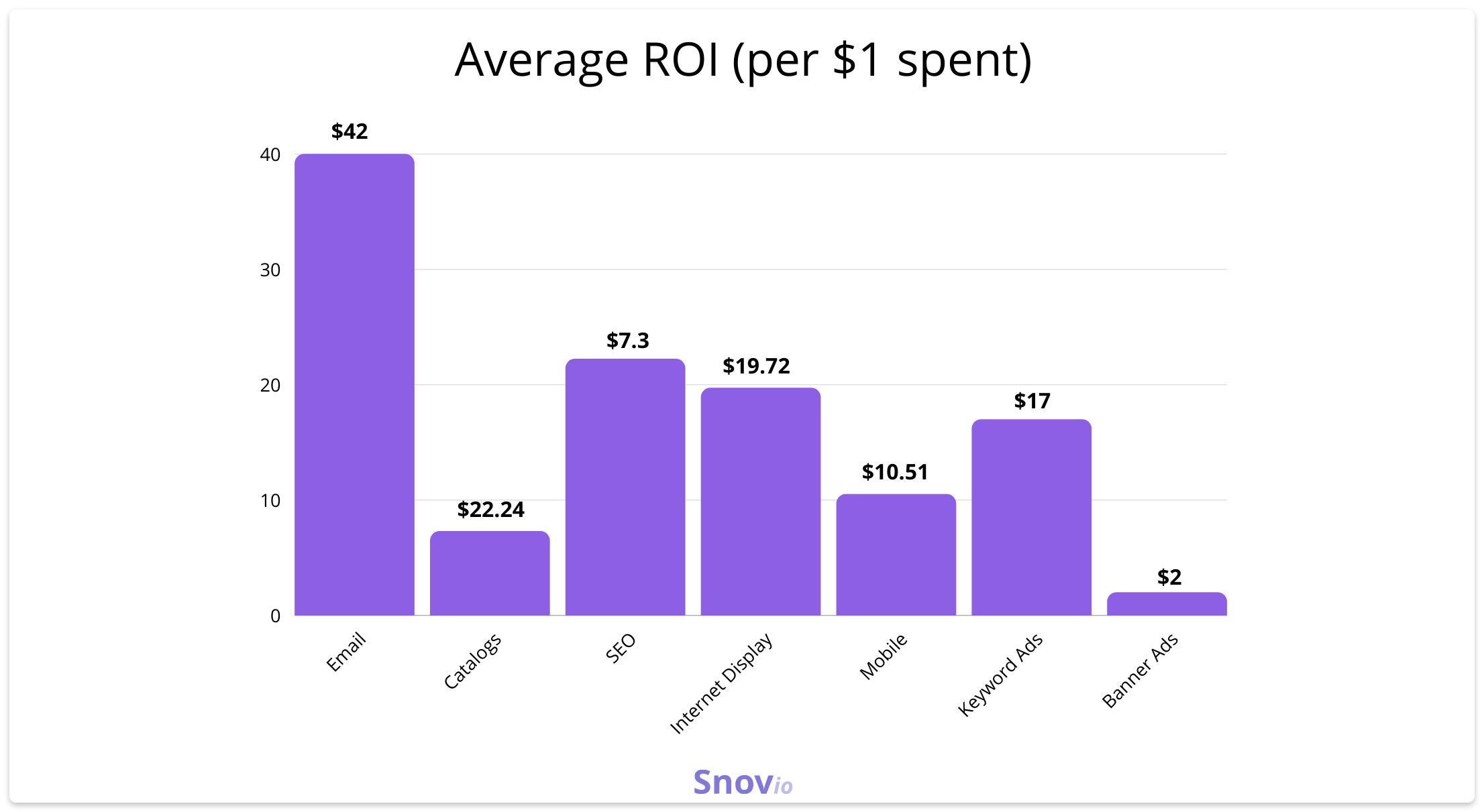Pursuing lead generation goals, companies tend to hunt for emails, and often not legally. While there are many effective ways to do email address search, businesses sometimes choose to commit the biggest marketing mistake ― they buy email lists.
In this post, we will unveil the truth behind this practice. We’ll talk about the advantages of email lists, solutions on how you can collect your emails, and reasons purchasing them is the last thing to do.
Outline:
Benefits of email lists
If you have any doubts whether you should build quality email lists, consider what advantages you may get from them:
- High ROI. Among all online marketing techniques, email marketing is the king when it comes to the pay-off, bringing you 4200% ROI. Just imagine: this is $42 for every $1 spent.

- Instant personal communication. Emails are delivered immediately, so you have more chances of reaching your target audience than if you used advertising. Besides, emails allow you to make your communication personalized and get a 20% increase in sales as a result.
- Better targeting. Staying in touch with your clients, you’ll be able to understand what they need and what email content they respond to. Segmenting your lists across specific demographic (for B2C) or firmographic (for B2B) attributes, you’ll improve your targeting.
- Converting prospects into customers. Sending your subscribers valuable content and updating them with your product improvements, you can increase your chances of turning them into clients.

How to Find Someone’s Email Address: 13 Easy Ways
December 12 2025

12 Best Email Finder Tools in 2025 (Features and Prices)
November 25 2025
How to build your email list?
To take care of your sender reputation and marketing efforts’ overall success, you should undertake reliable ways of building a quality list.
Use prospecting tools
Prospecting is a well-thought-out routine work that requires your thorough analysis of a prospect’s buyer persona. You should define channels you’ll use to find your potential leads and come up with the right tactics for reaching them.
To make this process easier, use prospecting tools, for instance, Snov.io Email Finder and Email Verifier. It will help you make your quality email list of prospects you are interested in, including top decision-makers within companies you consider potential customers.
Offer your audience valuable, engaging content
I guess you know a famous saying, “Give before you get.” There is no better place to apply it than email marketing. If you want to get the users’ subscription, you should give them something first — useful content they may derive from your landing page.
Besides, remember that apart from being informative, your web page must be good-looking and easy to navigate, so never neglect UX and UI design features. For example, look at the Overflow’s website, a design tool that helps create diagrams for rendering ideas. You will see how images and content work together:

The website is user-friendly, has a prominent CTA button for downloading the tool, and adds value by demonstrating how easy it is to create diagrams.
Use subscription forms
Get used to putting subscription forms on different pages of your website and don’t forget to experiment with their various types: fixed, floating, embedded, etc. Besides, if you use a single opt-in, you will need to ensure you have put an explicit consent checkbox on every form to comply with GDPR policy, for example:

Use a double opt-in
To avoid having junk email addresses in your email marketing lists, such as spam traps or bots, use a double opt-in. It will get users to sign-up using a subscription form and confirm their subscription via email, just like in the example of Mozilla:

Another advantage of using a double opt-in is that you’ll make your email list building legal by receiving the user’s explicit consent to get messages from you.
Offer a lead magnet
A lead magnet is something of value you offer to your potential subscribers in exchange for their subscription. Well, there are dozens of ideas for your lead magnets:
- E-book
- Checklist
- Webinar
- Cheatsheet of tips or resources
- Free trial
- Discount
- Free shipping
- Quiz, and many more.
Your choice of a perfect lead magnet will depend on what your audience may appreciate and fall for. For example, Marion offers users an e-book with valuable insights on how they can improve their website, which they will be able to download provided they sign up:

But what about buying email marketing lists?
Unfortunately, not many companies understand that collecting emails isn’t a lightning-like process. It does require some effort. So, businesses prefer an easier way — purchasing email lists. Let’s find out how it works.
As a rule, you may find hundreds of services on Google that offer targeted email lists:

The companies selling such lists usually offer thousands or even millions of business emails grouped around specific categories. The lists are based on industries, job titles, and other data claimed to be relevant to your business. And of course, these companies promise to supply you with only clean and verified email addresses.
The matter is that such services commonly don’t explain how they collect emails. What they give is some general information on how the process goes. For example, they may assure they contact companies directly via phone calls or surveys, have partnerships with marketing or research agencies, and so on.
They offer you a ‘promising’ list of contacts, which appears to be disappointing. So, if you ask me whether purchasing an email list is a good idea, I will undoubtedly say ‘No.’ And here’s why.
Why you should never buy email lists
To convince you not to buy email lists, consider my arguments against this practice:
Purchasing email lists is illegal
That’s the first thing you should think about before succumbing to the temptation. Penalties for purchasing email lists and sending spam vary from country to country. Certain laws regulate this, protecting users from receiving spam, for example, GDPR in Europe or the CAN-SPAM Act in the USA.
- The General Data Protection Regulation (GDPR) sets strict rules against purchasing email lists. The subscriber should express the explicit consent for receiving messages from a company. The fines for violating this rule can reach €20 million or 4% of the worldwide annual revenue.
- The CAN-SPAM Act sets the regulation all senders should comply with: a sender can’t sell a user’s email once they have unsubscribed. The violation of this Act will result in the penalty of up to $42,530 for every email.
So, purchasing email lists can never be legal. Laws are undisputable: collecting email addresses must be fair and gradual.
Email marketing software will take preventive measures
Many email marketing platforms want to act in accordance with the law, so they’ll require that all subscribers you have in your email lists have opted-in to get contacted by you. In case of a purchased list, this will be impossible. If you try to ignore these requirements, your account can be terminated.
The quality of a purchased list is usually poor
No matter what sellers have told you about the lists’ quality, they leave much to be desired as a rule. Among the most common problems they have are invalid or inactive email addresses. It’s natural that email open and click-through rates, in this case, will be rather low, whiсh will put under question the effectiveness of your email campaigns.
Subscribers will most likely mark your emails as spam
Users who have never agreed to get emails from you won’t expect your messages to invade their Inbox. This is their personal space, so they may not welcome any stranger. As a result, your email will have all chances of being marked as spam, which will affect your sender reputation in the long run.
While you should do your best to avoid your emails landing in the Spam folder and saving your deliverability rate from the downfall, purchased lists will only increase your chances of such an unpleasant result.
You might get blacklisted
A blacklist is a list that identifies IP addresses or domains as spam senders. Mailbox providers commonly use blacklists against unwanted emails. This year, the percentage of such messages has reached up to 45% of all emails.
In case of purchased lists, your messages might be considered spam. So eventually, you may find yourself on a blacklist too. Unfortunately, if you do, all your emails will be automatically sent to the Spam folder.
To get out of the blacklist, you’ll need to contact mailbox providers and prove that you’ve cleaned your mailing list and won’t ever send spam again. Still, there’s no guarantee you’ll be given a second chance.
Wrapping it up
Purchasing email marketing lists is a game not worth playing. It’s fraught with many dare consequences, starting from fines up to destroying your sender reputation. You’d better choose better ways of building your email list, such as making your content valuable for your subscribers, using subscription forms, offering lead magnets, and using prospecting services.
In case you feel prospecting becomes harder and more time-consuming than you expect, Snov.io’s all-in-one toolset may become your aid-kit.
And may the marketing and sales force be with you!




